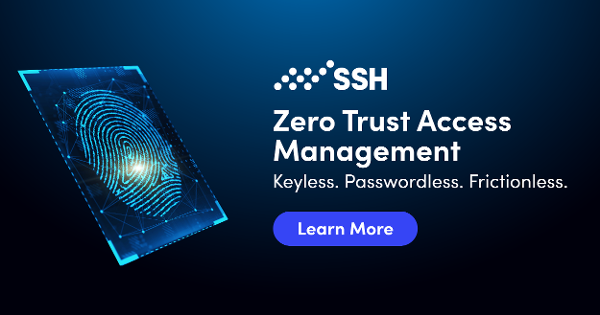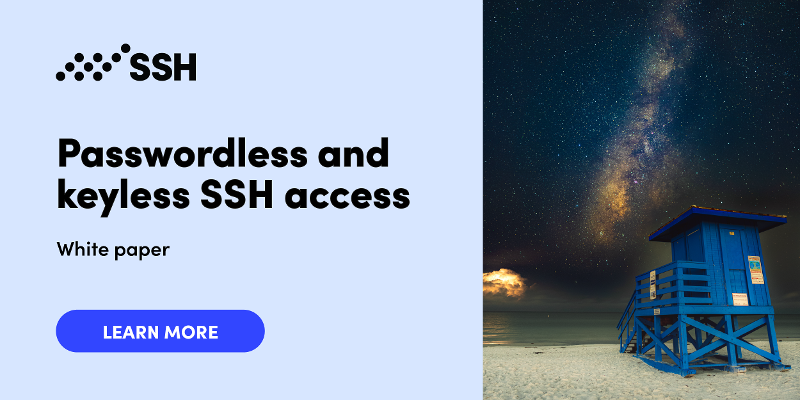A Guide to Keyless and Passwordless Authentication
Contents
Why Do Businesses Need Passwordless Authentication?
What is Passwordless Authentication?
How Does Passwordless Work?
What About Keys?
Keyless and Passwordless Authentication & Just-in-Time Zero Trust
Benefits of Keyless and Passwordless Authentication
Keyless and Passwordless Authentication Best Practices
Keyless and Passwordless Authentication Are the Future
SSH Zero Trust Solutions
Why Do Businesses Need Passwordless Authentication?
Passwords are everywhere. Since the dawn of the computer age, passwords have been the centerpiece of access and authentication technology. Since password-protected entry first came into use, IT security has advanced in many ways — we now have access to data encryption, secure file transfers, and multifactor authentication, among many other capabilities. But passwords have remained a mainstay of cybersecurity.
For basic security, passwords can be effective at preventing unwanted access into cybersystems. But passwords are a static solution. This means that once a password is established, it can’t change on its own. For a sustainable security solution, passwords and encryption keys must be changed regularly to effectively protect sensitive information.
Until recently, passwords and encryption keys have been the standard for data protection in enterprise systems. With an understanding that permanent credentials are less secure than dynamic passwords, businesses have spent countless hours and resources managing privileged access management (PAM) and enterprise key management (EKM) systems, ensuring access credentials are rotated regularly.
With passwordless authentication, ephemeral access credentials are now available for widespread use. This eliminates the need to manually rotate passwords and access keys — once the file or data has been accessed, the credential disappears, just in time. This means that passwordless authentication is highly secure, ensuring that enterprise passwords don’t fall into the wrong hands.
What is Passwordless Authentication?
Before we explore how SSH is changing the cybersecurity landscape, it’s important to understand exactly what passwordless authentication entails. The goal of passwordless authentication is simple: to avoid the security pitfalls associated with passwords while improving the user experience.
Since passwords gained prominence in the mid-20th century, secure systems have added additional layers of protection to ensure data integrity. Most recently, multi-factor authentication (MFA) has become a widespread alternative to simple password-based authentication. With MFA, users need to establish their personal identity to ensure they have the right access permissions. To do this, biometric authentication and multi-device authentication are often used.
But MFA can be a hassle, and multiple layers of credentials can make access complicated for even the right users. Moreover, MFA still uses traditional passwords and encryption keys — so it doesn’t fix the inefficiency of static passwords, which still need to be managed. Ultimately, passwordless authentication is a way to replace MFA with something more efficient, user-friendly, and secure.
How Does Passwordless Work?
The idea behind passwordless identification is to provide access for the right users, while protecting privileged users’ personal data. Passwordless access helps you eliminate the risk of leaked passwords and compromised information by using paired keys — one public key and one private key.
Here’s how it works: first, a privileged user creates an account with the organization. Once a user establishes a new identity, the user creates a private key that is only accessible to the person who possesses it. The new account is paired with a public key, which is held by the protected organization.
When it’s time for the right user to access their account, the private key must be unlocked with authentication. Once the private key is accessible, the organization is able to pair it with the public key. Pairing the private key with the public key is what allows the user to access the account at the right time, with the right level of privilege.
It’s important to note that passwordless authentication, by definition, aims to remove passwords from the authentication process. This means that, in a truly passwordless access setup, the credentials for unlocking the private key will not involve a password. Instead, passwordless authentication uses another type of MFA — whether it’s biometric, a physical token, or another personal identifier that cannot be leaked if the main enterprise falls victim to a cyberattack.
What About Keys?
Passwords aren’t the only type of static credential. To maximize the benefits of migrating to a passwordless environment, organizations must also consider their other permanent credentials — their keys. SSH keys outnumber passwords 10 to 1, and often go overlooked while organizations tie themselves in knots over password security. Yet these keys, like passwords, can represent a serious security threat if not properly managed.
This raises an important question — is there a way to become passwordless and keyless simultaneously?
Keyless Passwordless Authentication & Just-in-Time Zero Trust
Zero Trust (ZT) is the framework for today’s high-security enterprise systems. Using the Zero Trust model, even in-network devices, servers, applications — or any other target — must be verified before users can access sensitive information. MFA is another key component of Zero Trust, which allows you to increase confidence in each authentication effort. No matter which devices are in your corporate perimeter, Zero Trust helps to ensure your users are consistently authenticated.
Passwordless authentication solutions go hand-in-hand with Zero Trust architecture. When Zero Trust MFA uses passwords, users can quickly become fatigued with long login processes, repeated password requests, and disruptive MFA texts and emails. Since Zero Trust requires authentication at each step of user access, passwordless access allows users to move through IT systems with continuous verification, and without having to continuously log in and remember passwords.
The same principle applies to keys. If the users utilize keys instead of passwords, the keys must also be managed to mitigate major security risks. Using ephemeral authentication certificates, passwordless and keyless authentication ensures that the right users can access the right information on a per-use basis.
The Zero Trust concept establishes that authentication no longer requires permanent credentials like passwords or SSH keys. Instead, every session is authenticated just in time (JIT) for establishing the connection, using short-lived certificates. The certificates carry the required secrets to establish the connection, but the certificates automatically expire within minutes of authentication.
The user never handles any keys or passwords during the process, but everything happens under the hood. No keys or passwords are left behind to be managed either.
By pairing passwordless and keyless authentication, the Zero Trust security framework and the just-in-time concept are the way of the future.
Benefits of Keyless and Passwordless Authentication
Aside from significantly increased security, there are plenty of other major benefits of passwordless and keyless authentication. These include:
- Increased usability. When static credentials are out of the picture, users can access the right information without jumping through hoops. Traditional password-based authentication has required users to create complex passwords, then store them somewhere “safe” and remember them when it comes time to log in. Additionally, plenty of enterprises require users to manually rotate passwords or keys periodically. Passwordless and keyless authentication removes the burden of management, so users can access the right data without obstacles.
- Cost-effective operations: Password and key management is an expensive endeavor for IT teams. To manage passwords for a large organization, an entire team of admins may be necessary to answer customer questions, help reset passwords, and rotate and retire passwords. This process can be time-consuming and inefficient compared to a passwordless approach. Implementing passwordless authentication allows your enterprise to reduce IT management costs by avoiding the time-consuming process of password management. The same applies to key management with one fundamental difference — keys are notoriously difficult to find. In fact, most Privileged Access Management (PAM) solutions are not equipped to handle keys properly, so many keys are going undetected and unmanaged.
- Better security: Passwordless and keyless authentication have the potential to be a much more secure option than permanent credential-based access control. Passwords and keys have the potential to fall into the wrong hands — no matter how often they are rotated. When passwordless and keyless authentication is adopted, there is little doubt that the right user is accessing the right information.
Keyless and Passwordless Authentication Best Practices
By learning passwordless and keyless authentication best practices, you can streamline access management from the very beginning. When implementing any new IT stack, it’s important to test out your new approach using trial technology when possible — this can involve demos of passwordless and keyless services, as well as localized deployment of your new technology before implementing it across the enterprise.
With small-scale implementation, you can identify any challenges your users might have with passwordless and keyless technology and determine how to address these issues before implementing the technology on a company-wide scale. While testing out passwordless and keyless authentication, it’s important to gather feedback to understand exactly which parts of the new technology are posing a challenge for new users.
Once you implement passwordless and keyless authentication on a company-wide scale, guiding your employees through the user process is potentially the most important of all the best practices. To improve usability, you can establish training courses, provide specialized IT support, distribute FAQ sheets, or even designate members of your IT team to provide live assistance for new users.
Keyless and Passwordless Authentication Are the Future
Passwordless and keyless authentication solutions allow you to verify access at each step in the process. Combining passwordless and keyless authentication with the Zero Trust approach means access can become faster and easier for users, while improving security. For Zero Trust enterprises, passwordless and keyless access is a great way to save time and money — and maintain a strong approach to privileged access management.
Passwordless and keyless access management are consistently more secure than traditional solutions. Because passwordless and keyless authentication doesn’t rely on static access credentials, you’re eliminating the threat of unmanaged or stolen credentials from a password vault. Additionally, you can avoid the resources necessary to repeatedly rotate and manage all your enterprise passwords and keys.
As technology progresses, making certain changes just makes sense — and migrating to passwordless and keyless authentication is one of those changes.
SSH Zero Trust Solutions
SSH is a Defensive Cybersecurity solution provider that offers industry-standard security for large and small enterprises. With passwordless and keyless capabilities, our products allow you to optimize your privileged access management without compromising security. Because our products offer a hybrid approach, you can manage existing passwords and keys while migrating to passwordless and keyless at your own pace.
At SSH, our Zero Trust services address all your enterprise security needs. UKM Zero Trust is an encryption key management solution, for a Zero Trust approach to data encryption algorithms. PrivX offers privileged access management, without the need for passwords. And Tectia Zero Trust is our secure file transfer protocol, with SSH encryption and passwordless authentication solutions.
Your passwordless and keyless journey can start today. Contact us at SSH for more info on our Zero Trust solutions, and leave passwords and keys behind — for good.


